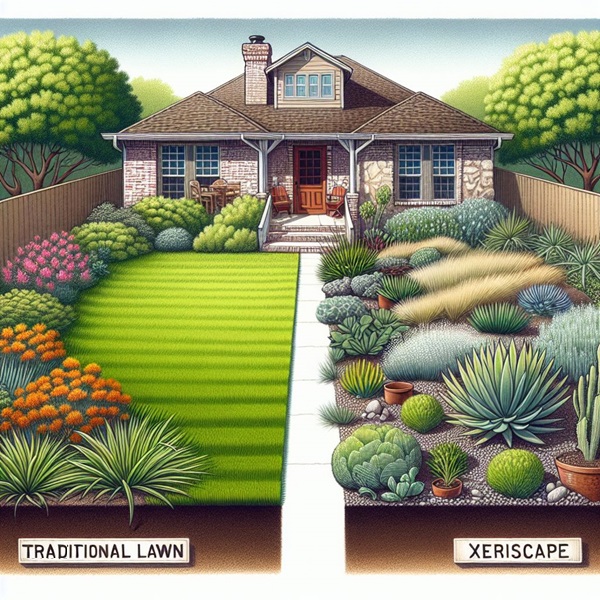Key Takeaways
- Xeriscaping is an eco-friendly landscaping approach that conserves water and complements Tennessee’s climate.
- Understanding and navigating HOA rules is crucial for successful
in Tennessee communities. - Choosing the right plants is key — native and drought-tolerant species thrive with minimal upkeep.
- Designing your xeriscape with both aesthetics and sustainability in mind will address HOA concerns and benefit the environment.
- Maintaining your xeriscape is straightforward and cost-effective, ensuring a beautiful yard year-round.
Thrive with Xeriscaping: A Tennessee Homeowner’s Guide
Have you ever looked at your yard and thought about how much water, time, and resources you pour into it? Well, xeriscaping is the solution that aligns perfectly with the eco-conscious spirit of Tennessee. It’s all about creating a landscape that’s not just easy on the eyes but also on the planet. And let’s face it, with the weather we get here in Tennessee, having a garden that can handle a bit of drought is a no-brainer.
What is Xeriscaping?
Xeriscaping is a landscaping philosophy that uses water-conserving techniques, native plants, and creative design to create an outdoor space that requires little to no irrigation. Think of it as a smart way to garden, where every drop of water is used efficiently. This doesn’t mean your yard will be just rocks and cacti; xeriscaping can be lush and full of life, reflecting the natural beauty of Tennessee’s landscapes.
Benefits of Embracing Xeriscape Principles
Why xeriscape? For starters, it slashes your water bill and cuts down on maintenance time. But that’s just the tip of the iceberg. Xeriscaping creates a habitat for local wildlife, reduces chemical runoff, and fights soil erosion. It’s gardening with a purpose, aligning your outdoor space with the rhythms of Tennessee’s environment.
Navigating HOA Landscaping Rules in Tennessee
Now, before you start transforming your lawn into a xeriscape wonderland, there’s a hurdle we need to clear: the HOA. Homeowners Associations can be sticklers for uniformity, but don’t worry. Tennessee law has your back, ensuring that you can xeriscape even if your HOA has different ideas. The key is to understand the rules and work within them.
Deciphering Your HOA’s Green Thumbs-Up
First things first, get your hands on those landscaping guidelines. They’ll outline what’s allowed and what’s not. Look for any mentions of native plants, mulch types, and irrigation systems. And remember, communication is key. Keep your HOA in the loop about your plans — they might be more supportive than you think.
Planning Your Xeriscape Within HOA Constraints
When planning your xeriscape, consider these steps:
- Sketch your vision: Map out your space, factoring in sun exposure, slopes, and existing vegetation.
- Choose your plants: Stick to native species that are accustomed to Tennessee’s weather patterns.
- Submit your plan: Present a detailed plan to your HOA for approval, emphasizing the benefits of xeriscaping.
Most importantly, show them that xeriscaping can be beautiful. Use photos of thriving xeriscape yards to illustrate your points and win them over.
Designing a xeriscape that gets the green light from your HOA involves a blend of creativity and strategy. It’s about showcasing that sustainability can go hand-in-hand with curb appeal. To make sure your design stands out, focus on a variety of colors, textures, and heights. Use plants that bloom at different times of the year for a yard that’s always in season.
Designing Your Xeriscape for Approval
Getting your HOA to nod yes to your xeriscape plan is about presenting a vision that aligns with the community’s aesthetic while being eco-friendly. Be prepared to explain how xeriscaping can enhance property values and community pride, not just your own water bill.
Creating a Xeriscape Layout that Works
Designing a xeriscape starts with understanding your space. Consider the sun’s path, the slope of your land, and the type of soil you have. Group plants with similar water needs together to create “hydrozones.” This not only conserves water but also makes maintenance a breeze. Your layout should be a thoughtful arrangement that takes visitors on a visual journey through your yard.
Collaborating with Your HOA for a Greener Tomorrow
Collaboration is crucial. When you present your plan, focus on the environmental benefits and cost savings of xeriscaping. Emphasize the use of native plants, which support local ecosystems and require less water. Assure your HOA that xeriscaping is a responsible choice that can elevate the community’s reputation as an environmentally conscious place to live.

Maintaining Your Xeriscape
One of the joys of xeriscaping is the low maintenance it requires. However, that doesn’t mean no maintenance. Your xeriscape will need some love to stay healthy and vibrant.
Simple Care for Sustainable Gardens
Upkeep for a xeriscape is all about observation and minimal intervention. Keep an eye on your plants, especially in the first year as they establish themselves. Mulching is your friend — it conserves moisture, suppresses weeds, and feeds the soil. And while you’ll rarely need to water, when you do, water deeply to encourage strong root growth.
Seasonal Tweaks to Keep Your Garden Flourishing
Seasons change, and so will your xeriscape’s needs. In spring, prune any dead or damaged branches. Summer might call for occasional watering during extreme heat. Fall is the time for planting new additions, and winter is for planning next year’s changes. Each season brings a chance to enhance your xeriscape’s beauty and functionality.
Finding Common Ground: Xeriscaping Meets Aesthetics
Beauty and water conservation can coexist, and that’s the heart of xeriscaping. By selecting a variety of plants that offer year-round interest, you can create a landscape that’s as visually appealing as it is environmentally responsible.
Mixing Function with Style in Your Yard
Function and style are the cornerstones of a successful xeriscape. Choose plants that serve a purpose — whether it’s providing shade, attracting pollinators, or preventing erosion — and arrange them in a way that’s visually pleasing. Use rocks and stones to add texture, and consider a pathway of stepping stones to invite exploration.
For example, a winding path through your garden not only adds charm but also reduces the amount of grass to water and mow. It’s these smart choices that make your xeriscape both functional and stylish.
Remember, xeriscaping isn’t just about the plants; it’s about creating an ecosystem. Incorporate elements like bird baths or insect hotels to invite wildlife into your garden, enriching the biodiversity of your neighborhood.
Community Impressions: The Value of Curb Appeal
Curb appeal goes beyond aesthetics; it’s about setting a standard for the community. A well-designed xeriscape can become a talking point, inspiring others to consider eco-friendly options for their yards. This ripple effect can transform the look and health of your entire neighborhood, one yard at a time.
Beauty and water conservation can coexist, and that’s the heart of xeriscaping. By selecting a variety of plants that offer year-round interest, you can create a landscape that’s as visually appealing as it is environmentally responsible.
Function and style are the cornerstones of a successful xeriscape. Choose plants that serve a purpose — whether it’s providing shade, attracting pollinators, or preventing erosion — and arrange them in a way that’s visually pleasing. Use rocks and stones to add texture, and consider a pathway of stepping stones to invite exploration.
For example, a winding path through your garden not only adds charm but also reduces the amount of grass to water and mow. It’s these smart choices that make your xeriscape both functional and stylish.
Remember, xeriscaping isn’t just about the plants; it’s about creating an ecosystem. Incorporate elements like bird baths or insect hotels to invite wildlife into your garden, enriching the biodiversity of your neighborhood.
Curb appeal goes beyond aesthetics; it’s about setting a standard for the community. A well-designed xeriscape can become a talking point, inspiring others to consider eco-friendly options for their yards. This ripple effect can transform the look and health of your entire neighborhood, one yard at a time.
Example Xeriscaping Plants
| Plant | Description | Estimated Cost |
|---|---|---|
| Coneflower (Echinacea purpurea) | Native perennial with showy purple flowers, drought-tolerant. | $5-10 per plant |
| Butterfly Bush (Buddleja davidii) | Flowering shrub that attracts butterflies, low water needs. | $15-25 per plant |
| Yucca (Yucca filamentosa) | Evergreen succulent with striking foliage, very drought-resistant. | $10-20 per plant |
| Blanket Flower (Gaillardia) | Vibrant daisy-like flowers, thrives in hot, dry conditions. | $5-10 per plant |
| Little Bluestem (Schizachyrium scoparium) | Native ornamental grass with blue-green foliage, low water use. | $8-15 per plant |

Frequently Asked Questions (FAQ)
It’s natural to have questions when embarking on a new gardening adventure like xeriscaping. Let’s tackle some of the most common queries to help you get started on the right foot.
Can I Xeriscape if I live in a HOA community?
Yes, you can! Tennessee law supports homeowners’ rights to xeriscape. The trick is to present a well-thought-out plan that meets the aesthetic standards of the HOA. Communication and cooperation are key to gaining approval for your eco-friendly yard.
- Review your HOA’s landscaping guidelines.
- Design a xeriscape plan that enhances the community’s look.
- Discuss your plan with the HOA board and be open to feedback.
What are the most cost-effective plants for xeriscaping in Tennessee?
When it comes to cost-effective xeriscaping in Tennessee, native plants are your best bet. They’re adapted to the local climate and require less care. Look for Tennessee natives like Purple Coneflower, Black-Eyed Susan, and Blazing Star. These plants are not only affordable but also resilient and beautiful.
Does xeriscaping save money in the long term?
Definitely! While there might be some upfront costs to establish your xeriscape, the long-term savings are significant. You’ll spend less on water, fertilizers, and maintenance. Over time, these savings add up, making xeriscaping a smart financial choice as well as an environmental one.
How does xeriscaping contribute to sustainable living?
Xeriscaping is a cornerstone of sustainable living. It reduces water usage, supports local wildlife, and minimizes the need for chemical fertilizers and pesticides. By xeriscaping, you’re creating a garden that lives in harmony with Tennessee’s natural ecosystems.
Are there any legal protections for xeriscaping in Tennessee?
Tennessee homeowners are protected by state laws that encourage water-wise landscaping. These laws ensure that you can implement xeriscaping even if you’re part of an HOA. It’s important to know your rights and work within the legal framework to create your eco-friendly yard.
- Check Tennessee’s water conservation laws.
- Understand your rights as a homeowner.
- Use these laws to negotiate with your HOA if necessary.
In conclusion, xeriscaping in Tennessee can be a rewarding endeavor that benefits both your wallet and the environment. With a little planning, cooperation, and creativity, you can transform your outdoor space into a sustainable oasis that complies with HOA regulations and contributes to a greener community. Happy xeriscaping!
Understanding the rules and regulations of your local Homeowners’ Association (HOA) is crucial when considering xeriscaping in Tennessee. It’s important to ensure that your landscaping plans are compliant with HOA guidelines to avoid any potential issues. Additionally, selecting the right plants for your xeriscape can make all the difference in water conservation and ease of maintenance. Researching plants that are native to Tennessee and can thrive in the local climate without extensive watering will be key to a successful xeriscaping project.





Leave a Reply